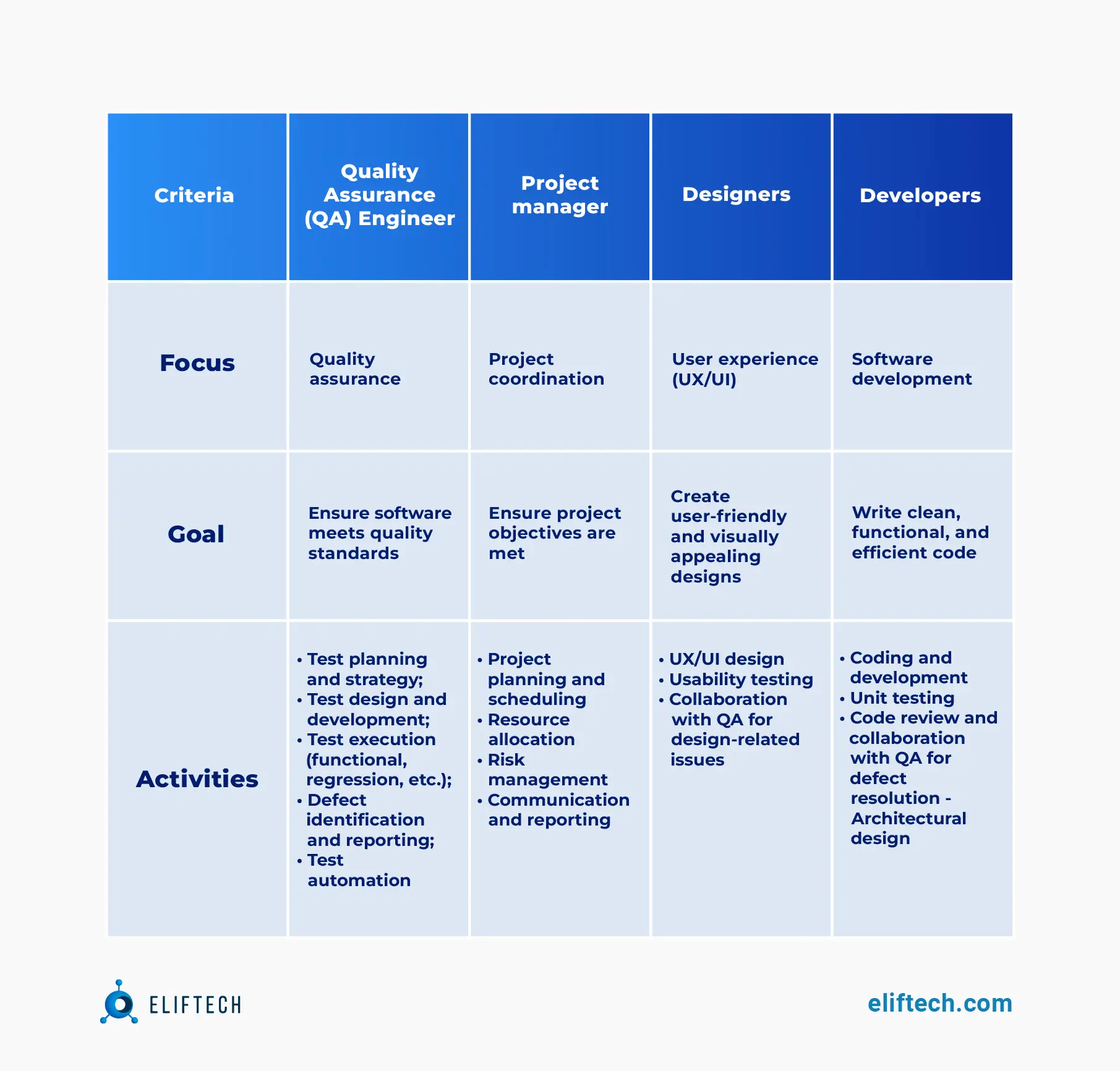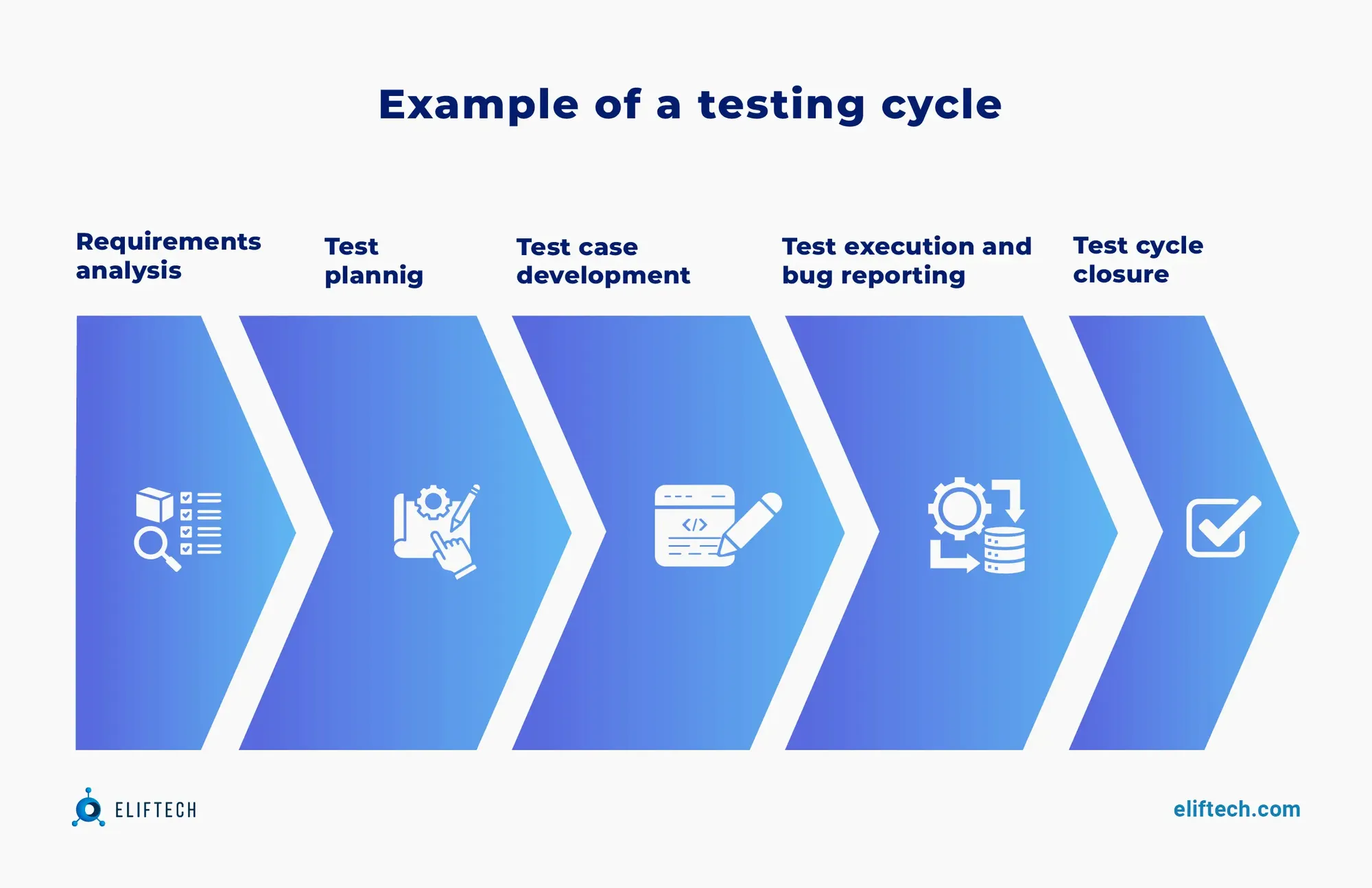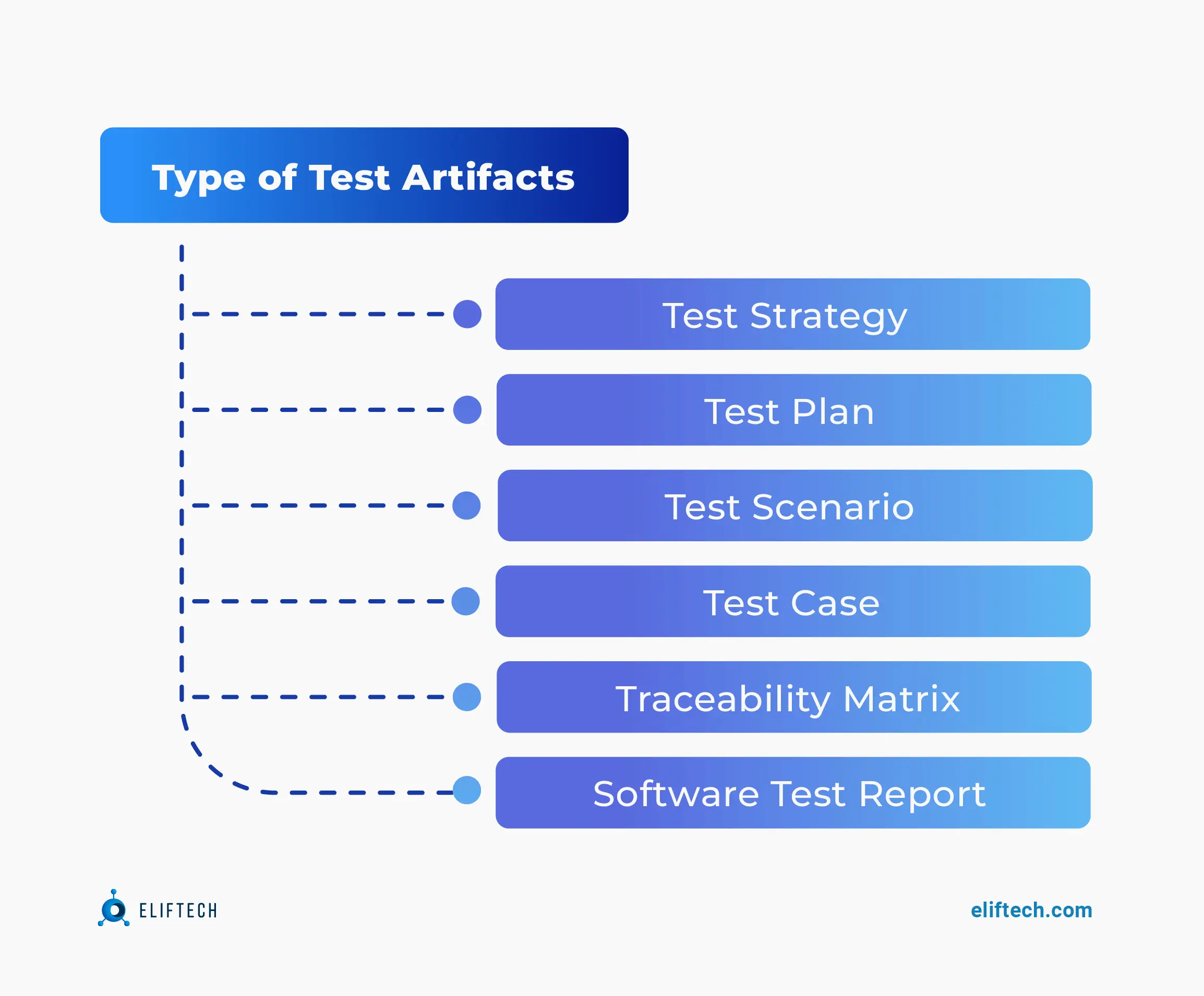Outsourcing
How QA as a Service Works at ElifTech

Quality is generally transparent when present, but easily recognized in its absence. Behind every successful software solution lies a rigorous QA process that ensures its reliability and success in the marketplace. In fact, a survey by Capgemini found that companies allocate about 35% of their IT budget to QA and testing. But how can you ensure a consistent and comprehensive QA implementation while focusing on what you do best - building revolutionary software?
The answer might lie with QA as a Service. QA and testing work alongside development, where QA specialists regularly perform quality checks, and developers fix bugs to fine-tune the product before it goes live. It's a crucial part of development because it saves money, speeds up product launches, and ensures that when your product is launched, it has as few bugs as possible if not none at all.
This blog post will unpack the workings of QA as a Service, including its impacts and benefits for development teams and consumers. In a realm where no two software ecosystems are the same, we'll explore how this service can adapt to varying development dynamics, providing crucial testing support where it's needed most.
QA Roles and Responsibilities: Who gets the QA jobs done?
To escape the costly repercussions of software defects and bugs, businesses necessitate comprehensive QA. But before we delve into describing the participants in the QA as a Service process, there is one important point to clarify first. It's natural for CEOs and top managers to wonder: why do I need QA if I can hire competent developers who won't create these bugs?
In most cases, the bugs we find during outsource QA testing aren't because the developers are bad at their job or made wrong choices. They usually appear in situations we couldn't predict, and we only see them after we've put things into action. For instance, it might turn out that some requirements just don't work together in a project, or when we try to customize things too much, it can lead to unexpected problems. Some bugs occur due to the technical shortcuts we use and how the team handles them.
Moreover, a decision to outsource QA testing provides invaluable insights into the product's overall condition and risk areas, earmarking them for necessary improvements for a flawless user experience. So, the QA as a Service process is a collaborative effort that extends beyond the responsibilities of QA engineers and testers. Project managers, designers, and developers also play significant roles in the QA test process.

QA Engineers
QA engineers are the main responsible persons in the QA test process. They are dedicated specialists, carefully checking all parts of the software for possible problems. In brief, they do the following:
- Review the Product Backlog to ensure it follows the rules.
- Ensure that the UX/UI elements are user-friendly and efficient, with no loose ends or incomplete features.
- Create test plans that outline the testing strategy, scope, objectives, and required resources for the project.
- Execute various tests, including functional testing and user acceptance testing, to identify defects and ensure the software functions correctly.
- Keep a record of any problems they find and ensure they get fixed.
- Create test automation scripts to streamline repetitive testing tasks and expand test coverage.
- Measure how good the software is and report the results.
- Work closely with project managers, designers, and developers to address issues and prioritize fixes.
- Perform Sanity Testing after each build release. (which is a quick and basic form of testing to check if the most critical functions of a software application work properly after making small changes or updates. It helps ensure that the recent changes haven't broken the software's core functionality.)
Project Managers
Project managers are in charge of setting schedules and deciding who does what in software testing. They also make sure things stay on track and handle risks. PMs collaborate with QA teams to ensure they do their job well while keeping the project on target. Plus, after our QA specialist completes the documentation, the PM always double-checks it for accuracy.
Designers
Although their role isn't directly related to the QA as a Service process, the designs they make should be user-friendly. Designers help QA by ensuring the look and feel of the software is nice and works well. To create the best user experience, they should carry out usability tests during the design phase before sending the app to QA.
Developers
Developers work hand in hand with QA professionals to fix issues and prevent defects on the spot. Actually, they start the testing cycle. They are responsible for conducting Smoke Testing before handing over the software build to QAs – a quick and basic set of tests to ensure that the build is stable enough for further, more detailed testing. The term "smoke" refers to the idea that if there's a major issue (like a fire), you'd see smoke and immediately address it before it turns into a bigger problem.
5 Steps of the QA as a Service Process
While outsourced quality assurance happens alongside project development, it doesn't always start right away. When you do software testing and correctly set up the QA as a Service process during development, you can achieve high-quality results, make the most of your resources, and save money. It's best to involve a QA engineer as early as possible in the project planning to achieve these goals.

Step 1: Requirements Analysis
In the initial software testing outsourcing lifecycle phase, the QA team focuses on understanding the product from a testing perspective. It involves collaborative brainstorming sessions with all project stakeholders.
During these sessions, the team delves into various aspects, including business, software architecture, design requirements, system, and integration requirements. They also actively seek out potential blind spots – areas that might be overlooked in the requirements. Our QA team also double-checks that they fully understand product privacy requirements, ensuring that our testing is fully compliant with privacy regulations and guidelines.
Based on the insights gained in this phase, the QA team can:
- Set the right priorities and goals for the QA test process. This helps determine what aspects of the product require the most attention and testing efforts.
- Decide which types of testing are most suitable for the product, considering factors such as functionality, performance, security, and user experience.
- Check the backlog structure and user stories. Software requirements are often written as user stories. The QA engineer needs to make sure that the backlog is set up correctly and that user stories don't have issues like the user interface (UI) not matching the user story's context. The QA engineer also needs to confirm that each user story is unique, detailed, can be traced and tested, and has the right priority.
- Document testable requirements to define specific aspects of the product that need to be tested
- Create templates for the key project documents that will be used, including the Test Plan, Traceability Matrix, Checklist, and Test Case documents.
- Consider the feasibility of automation to avoid repetitive actions and increase test coverage (optional because some projects don’t require automation testing).
- Create a Requirements Traceability Matrix (RTM) to map user requirements to specific test cases, ensuring clear alignment between requirements and testing coverage.
Step 2: Test Planning
With all the important information in mind, we move on to the test planning stage, where we outline how we'll conduct testing, what we'll test, and what our goals are.
During this phase, test managers carefully assess the extent of testing needed, its cost, and the time it will take. They consolidate all the vital project requirements into a comprehensive Test Plan. This plan also incorporates a test strategy, which outlines the overall approach, tools, and techniques we'll use.
Additionally, we include a quality plan that establishes our quality objectives, how we'll measure them, and the processes to maintain top-notch quality.
We have a sprint plan that aligns testing with the development sprints to keep everything in sync. This ensures timely testing within each sprint cycle.
The primary outcome of this phase is a document that details all the agreed-upon testing aspects, the test schedule, estimates of testing effort, and timelines for each step.
Step 3: Test Case Development
In the test cases development phase, the QA team gets to create specific test cases to check if the software does what it's supposed to do. They make step-by-step plans, predict what should happen, and figure out what test data they need.
A few things are crucial for each test case: it must be efficient and clear and cover all the software requirements. The team uses a requirements traceability matrix as a handy tool to ensure they're not missing anything. Testers also use the test plan to explore the product and gather the right info for creating test cases. If necessary, they might even create test automation scripts.
Our team also configures the test environment. Test environments are the software and hardware on which testers execute test cases. It’s important that your test environment covers all environments the user can potentially use in the real world, including servers, databases, and operating systems. This part can be a bit time-consuming, but it's important to ensure that when testers run their test cases, they do it efficiently.
Step 4: Test Execution and Bug Reporting
During the test execution phase, testers put the designed test cases into action to check if the software works as it should and if there are any problems. Testers stick to test plans to make sure they do the tests the same way each time.
When they run the tests, there are three possible results:
- "Pass" means the test went well and everything worked as expected.
- "Fail" means there was a problem, and the test didn't work. The testers hand over the reworks to the development team so they can fix it.
- "Block" means they couldn't run the test because something outside or inside the software stopped them.
These test case results shape the test reports. Test results reports provide a summary of what happened during testing. They tell us if the tests passed or failed, point out any problems (defects), and note if things didn't go as expected.
After all, testers conduct regression testing to ensure that software changes or updates haven't introduced new defects or disrupted existing functionality. In simple words, regression testing involves retesting previously validated features to ensure they still work correctly.
Based on the results of this phase, outsource quality assurance specialists create a test case execution report, a bug report, and a list of improvements.
Step 5: Test Cycle Closure
Test cycle closure is when we officially wrap up the testing cycle and its execution. So, the last thing we do is create a test closure report. Before making this report, we look back at the whole QA test process and each part to ensure we met our main goals.
We make the closure report when our testing process hits the exit criteria, which is usually when we pass about 90% of the tests. This report has a lot: how the tests went, how much it cost, and what we tested. It also has a bug report with all the details about any problems we found.
But, sometimes, we let real users test the software in a user acceptance testing phase. If they find any more problems, we fix them before releasing the software. This gives us a better chance of having a successful release.

How Long Does QA Outsourcing Testing as a Service Typically Take?
Testing duration can vary widely depending on the specific project, its complexity, and the scope of testing required. There's no one-size-fits-all answer to how long QA as a Service typically takes, as it can range from a few days to several weeks or even months. In terms of percentage, it typically takes about 20% to 30% of the entire project's lifecycle.
However, we’ve prepared a table highlighting general estimates.
However, these estimates are meant to give you a general idea. Actual timelines can differ based on your project's unique specifications and circumstances. If you're interested in discussing further, reach out to our team to get more precise calculations.
How to Manage QA Outsourcing Software Testing Challenges
Usually, customers who don't know much about how QA works tend to underestimate its importance and our engineers' difficulties when providing software testing. These misunderstandings can make it tough for outsource quality assurance specialists to do their best.
Let's look at the main challenges our QA engineers often deal with in software testing outsourcing based on what we've learned at ElifTech.
Challenge 1: Evolving requirements
We recommend investing more time in thoroughly understanding and prioritizing requirements before development begins. While this may not eliminate all future changes, it will certainly reduce their impact on the team.
So, at ElifTech, QA engineers are integrated into the planning and design phases, allowing them to gain a deep understanding of project requirements and potential challenges. This early involvement helps prevent issues before they occur.
Plus, ElifTech adapts swiftly to changing requirements by following Agile testing methodologies. We engage in ongoing discussions with clients to stay in sync with evolving project needs. This flexibility allows us to effectively adjust test plans and cases to match shifting requirements.
Challenge 2: Tight project deadlines
To meet project deadlines, ElifTech integrates testing seamlessly into the development process. We employ automated testing, which runs continuously as code changes are made. This approach accelerates testing and ensures that quality remains a top priority, even under tight schedules.
Challenge 3: High product quality comes with a cost
Clients often expect top-quality products without wanting to invest extra time in testing. However, achieving high product quality does require additional resources, especially for demanding technical requirements.
Either way, rest assured we'll handle the rest and explore ways to minimize the cost of fixing any issues.
Challenge 4: Stakeholders lack expertise and knowledge about outsource quality assurance value
In some projects, stakeholders lack knowledge about the importance and fundamentals of QA outsourcing. That’s why it can result in testing without QA experts, which means not benefiting from their experience and deep knowledge of software testing. This can lead to poor test planning and execution, neglecting essential QA aspects, and increasing the risk of failure.
As you read this article, you're less likely to face this challenge. However, keep in mind that a deeper understanding of QA as a Service will improve communication with your tech partner and help you achieve your goals.
Challenge 5: Inadequate test coverage
Test coverage can take a hit when there's a shortage of dedicated QA staff.
Outsourcing QA specialists are skilled at identifying scenarios, edge cases, and potential issues requiring thorough testing. Certain parts of the software may go untested without their involvement, leading to overlooked bugs and vulnerabilities.
So, ensure you have a competent quality assurance outsourcing team on board and a well-organized testing process in place.
What Can You Do as a Stakeholder to Enhance QA in Software Development?
As a stakeholder, there are several actions you can take to enhance outsourcing quality assurance (QA):
- Maintain open and clear communication with the outsourcing QA team. Ensure that they have a deep understanding of your expectations, requirements, and priorities.
- Involve quality assurance outsourcing experts from the project's inception. Early collaboration allows for better planning and the identification of potential issues before they become major problems.
- Work closely with QA to define clear and detailed requirements. Well-defined requirements are crucial for effective testing.
- Be realistic with project timelines. Rushing QA can lead to incomplete testing and increased risks.
- Allocate sufficient resources, including time and personnel, to QA outsourcing efforts. Adequate resources improve the quality of testing.
- Clearly define acceptance criteria for each project phase. QA should be able to refer to these criteria to ensure that the software meets your expectations.
- Establish a feedback loop between stakeholders, developers, and QA. Promptly address issues and changes to prevent misunderstandings.
- Participate in UAT to provide real-world feedback. Your input can uncover usability issues and refine the product.
- Understand that thorough testing may result in delays. Balancing speed and quality is essential.
- Listen to QA recommendations and act on them. They often have insights that can enhance the final product.
- Foster a culture of continuous improvement within the outsourcing QA team. Allow them to adopt new tools and practices to stay effective.
- Foster transparency by sharing project updates and changes. This helps QA adjust their testing accordingly.
By actively engaging in these actions, you can contribute significantly to the success of QA in software development and ultimately achieve a higher-quality product.
Outsourced Software Testing Services at ElifTech
ElifTech provides a comprehensive suite of testing solutions tailored to meet the diverse needs of clients across various industries. These services encompass manual and automated testing methodologies. One of the hallmarks of our approach is the implementation of rigorous QA procedures. Experienced testing teams follow industry best practices and adhere to established QA methodologies to conduct a wide array of tests, including unit testing, integration testing, regression testing, and user acceptance testing (UAT).
Additionally, our team conducts a QA audit to assess the effectiveness and efficiency of the testing processes. QA audit involves a systematic review of the testing procedures, tools, documentation, and team competence to identify areas for improvement. Through these audits, we can fine-tune the testing strategies, enhance collaboration between development and testing teams, and optimize the overall testing workflow.
Moreover, our services extend beyond functional testing to encompass various specialized testing domains. These include performance testing to evaluate the system's responsiveness and stability under different load conditions, security testing to identify vulnerabilities and ensure data protection, and compatibility testing to validate the software's compatibility with different devices, operating systems, and browsers. A comprehensive testing approach during software QA processes ensures that the software not only meets the client's requirements but also adheres to industry standards and regulations.
Wrapping up, our customer-centric approach ensures excellence in every line of code, making the decision to outsource quality assurance a key player in your success story. Reach out to our team and experience the unparalleled benefits of QA as a Service.
